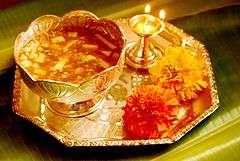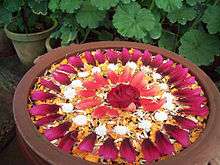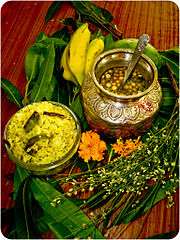Ugadi
Ugadi (Ugādi, Samvatsarādi, Yugadi) is the New Year's Day for the States of Andhra Pradesh, Telangana and Karnataka in India.[2] It is festively observed in these regions on the first day of the Hindu lunisolar calendar month of Chaitra.[3] This typically falls in March or April of the Gregorian calendar.[3]
| Ugadi | |
|---|---|
 Ugadi Pachadi with New Year prayer puja tray | |
| Also called | Yugadi, Samvatsaradi Telugu and Kannada New Year |
| Observed by | Hindus in Telangana, Andhra Pradesh, Karnataka, Maharashtra |
| Type | Religious (Hindu), social, cultural |
| Celebrations | Kolam-Rangoli, visiting Temples, Feast with Holige and Bevu Bella |
| Begins | 1st day of Chaitra |
| Date | March (generally), April (occasionally) |
| 2019 date | Sat, 6 April in India, Fri, 5 April in the USA |
| 2020 date | Wed, 25 March in India,[1] Tue, 24 Mar in the USA |
| Frequency | Annual |
| Related to | Mesha Sankranti, Gudi Padwa, and other regional Hindu new year’s day |

The day is observed by drawing colorful patterns on the floor called kolamulus ( Kannada: Rangoli , Telugu: Muggulu, ) mango leaf decorations on doors called torana (kannada : torana,Telugu: Toranalu ), buying and giving gifts such as new clothes, giving charity to the poor, special bath followed by oil treatment, preparing and sharing a special food called pachadi, and visiting Hindu temples.[4][5] The pachadi is a notable festive food that combines all flavors – sweet, sour, salty, bitter, astringent and piquant (spicy hot). In Telugu and Kannada Hindu traditions, it is a symbolic reminder that one must expect all flavors of experiences in the coming new year and make the most of them.[6]
Ugadi has been an important and historic festival of the Hindus, with medieval texts and inscriptions recording major charitable donations to Hindu temples and community centers on this day.[7] The same day is observed as a New Year by Hindus in many other parts of India. For example, it is called Gudi Padwa in Maharashtra, but sometimes observed a Gregorian day earlier because the lunar day starts and ends in Hindu calendar according to the position of the moon. In Karnataka, the festival is celebrated as Yugadi.
Terminology
The name Yugadi or Ugadi is derived from the Sanskrit words yuga (age) and ādi (beginning): "the beginning of a new age".[6] Yugadi or Ugadi falls on "Chaitra Shudhdha Paadyami" or the first day of the bright half of the Indian month of Chaitra. This generally falls in late March or early April of the Gregorian calendar.[3][4]
The people of Karnataka use the term Yugadi (ಯುಗಾದಿ) and the people of Andhra Pradesh and Telangana use the term Ugadi (ఉగాది) for this festival.
Practices

The Kannada, Kodava, Telugu and the Tulu diaspora in Karnataka, Telangana, Andhra Pradesh, Tamil Nadu and Kerala celebrate the festival with great fanfare; gatherings of the extended family and a sumptuous feast are 'de rigueur'. The day begins early with ritual showers, rubbing the body with perfumed oil, followed by prayers.[5]

Preparations for the festival begin a week ahead. Houses are given a thorough clean.[5] People buy new clothes and Dhoti and buy new items for the festival, decorate the entrance of their houses with fresh mango leaves.[4] Mango leaves and coconuts are considered auspicious in the Hindu tradition, and they are used on Ugadi. People also clean the front of their house with water and cow dung paste, then draw colorful floral designs.[4] People offer prayer in temples. The celebration of Ugadi is marked by religious zeal and social merriment.[8][6][9][10][6] According to Vasudha Narayanan, a professor of Religion at the University of Florida:[11]
The pacchadi festive dish symbolically] reminds the people that the following year – as all of life – will consist of not just sweet experiences, but a combination of sweet, sour, salty, and bitter episodes. Just as the different substances are bound together, one is reminded that no event or episode is wholly good or bad. Even in the midst of bitter experiences, there are sweet moments. One is also reminded that the experience of taste is transitory and ephemeral; so too, is life, and one has to learn to put pain and pleasure in proper temporal perspective.[6]
Special dishes are prepared for the occasion.In Karnataka etables olige, vobattu and mango pickles are made .In Andhra Pradesh and Telangana, eatables such as "pulihora, bobbatlu (Bhakshalu/ polelu/ oligale), New Year Burelu and Pachadi" and preparations made with raw mango go well with the occasion. Of this pachadi (or Ugadi pacchadi) is most notable, and consists of a chutney-like dish which includes ingredients to give all flavors: sweet, sour, tangy and bitter.[12] This festive Hindu food is made from tamarind paste, neem flowers, brown sugar or sweet jaggery, salt, and sometimes mango. It is a symbolic reminder of complex phases of life one should reasonably expect in the new year.[11][13][14]
Greetings
In Kannada, the greeting is Yugadi Habbada Shubhaashayagalu - ಯುಗಾದಿ ಹಬ್ಬದ ಶುಭಾಶಯಗಳು ("Greetings for the festival of Yugadi") or Hosa varshada shubhashayagalu - ಹೊಸ ವರ್ಷದ ಶುಭಾಶಯಗಳು ("Greetings on the New Year").
In Telugu, the traditional greetings for Ugadi are kroththa yeta, ugadi panduga, palukarimpulu or ugadi subhaakankshalu - "క్రొత్త ఏట" / "ఉగాది పండుగ" పలుకరింపులు, లేదా ఉగాది శుభాకాంక్షలు ("Greetings for the festival of Ugadi") and Nutana samvastara shubhaakankshalu -నూతన సంవత్సర శుభాకాంక్షలు ("Greetings on the New Year").
Related festivals
The Hindus of Maharashtra term the same festival, observed on the same day, Gudi Padwa (Marathi: गुढी पाडवा).
The Sindhis, people from Sindh, celebrate the same day as Cheti Chand, which is the beginning of their calendar year.[15]
Manipuris also celebrate their New Year as Sajibu Nongma Panba on the same day.
The Hindus of Bali and Indonesia also celebrate their new year on the same day as Nyepi.
See also
References
- "2020 Chaitra Navratri, Vasanta Navratri Calendar for New Delhi, NCT, India". Drikpanchang: Hindu Calendar for the World. Retrieved 16 March 2020.
- Karen-Marie Yust (2006). Nurturing Child and Adolescent Spirituality: Perspectives from the World's Religious Traditions. Rowman & Littlefield. pp. 228–229. ISBN 978-0-7425-4463-5.
- Roshen Dalal (2010). Hinduism: An Alphabetical Guide. Penguin Books. p. 427. ISBN 978-0-14-341421-6.
- Maithily Jagannathan (2005). South Indian Hindu Festivals and Traditions. Abhinav Publications. pp. 77–78. ISBN 978-81-7017-415-8.
- Jeaneane D. Fowler (1997). Hinduism: Beliefs and Practices. Sussex Academic Press. pp. 72–73. ISBN 978-1-898723-60-8.
- Narayanan, Vasudha (1999). "Y51K and Still Counting: Some Hindu Views of Time". Journal of Hindu-Christian Studies. Butler University. 12 (1): 17–18. doi:10.7825/2164-6279.1205.
- K.V. Raman (2003). Sri Varadarajaswami Temple, Kanchi: A Study of Its History, Art and Architecture. Abhinav Publications. pp. 97–98. ISBN 978-81-7017-026-6.
- Gabriella Eichinger Ferro-Luzzi 91977), Ritual as Language: The Case of South Indian Food Offerings, Current Anthropology, University of Chicago Press, Vol. 18, No. 3 (September 1977), pages 507–514
- Neem - Ancient Tree, Modern Miracle, Warm Earth, National Library of Australia, No. 83, Mar/Apr 2009, pages 36-37
- Devagi Sanmugam; Shanmugam Kasinathan (2011). Indian Heritage Cooking. Marshall Cavendish. pp. 96–97. ISBN 978-981-4435-08-6.
- Narayanan, Vasudha (1999). "Y51K and Still Counting: Some Hindu Views of Time". Journal of Hindu-Christian Studies. Butler University. 12 (1): 17–18. doi:10.7825/2164-6279.1205.
- Gabriella Eichinger Ferro-Luzzi 91977), Ritual as Language: The Case of South Indian Food Offerings, Current Anthropology, University of Chicago Press, Vol. 18, No. 3 (September 1977), pages 507–514
- Neem - Ancient Tree, Modern Miracle, Warm Earth, National Library of Australia, No. 83, Mar/Apr 2009, pages 36-37
- Devagi Sanmugam; Shanmugam Kasinathan (2011). Indian Heritage Cooking. Marshall Cavendish. pp. 96–97. ISBN 978-981-4435-08-6.
- "Ugadi a time to rejoice". The Hindu. Chennai, India. 4 April 2005.
External links
| Wikimedia Commons has media related to Ugadi. |


